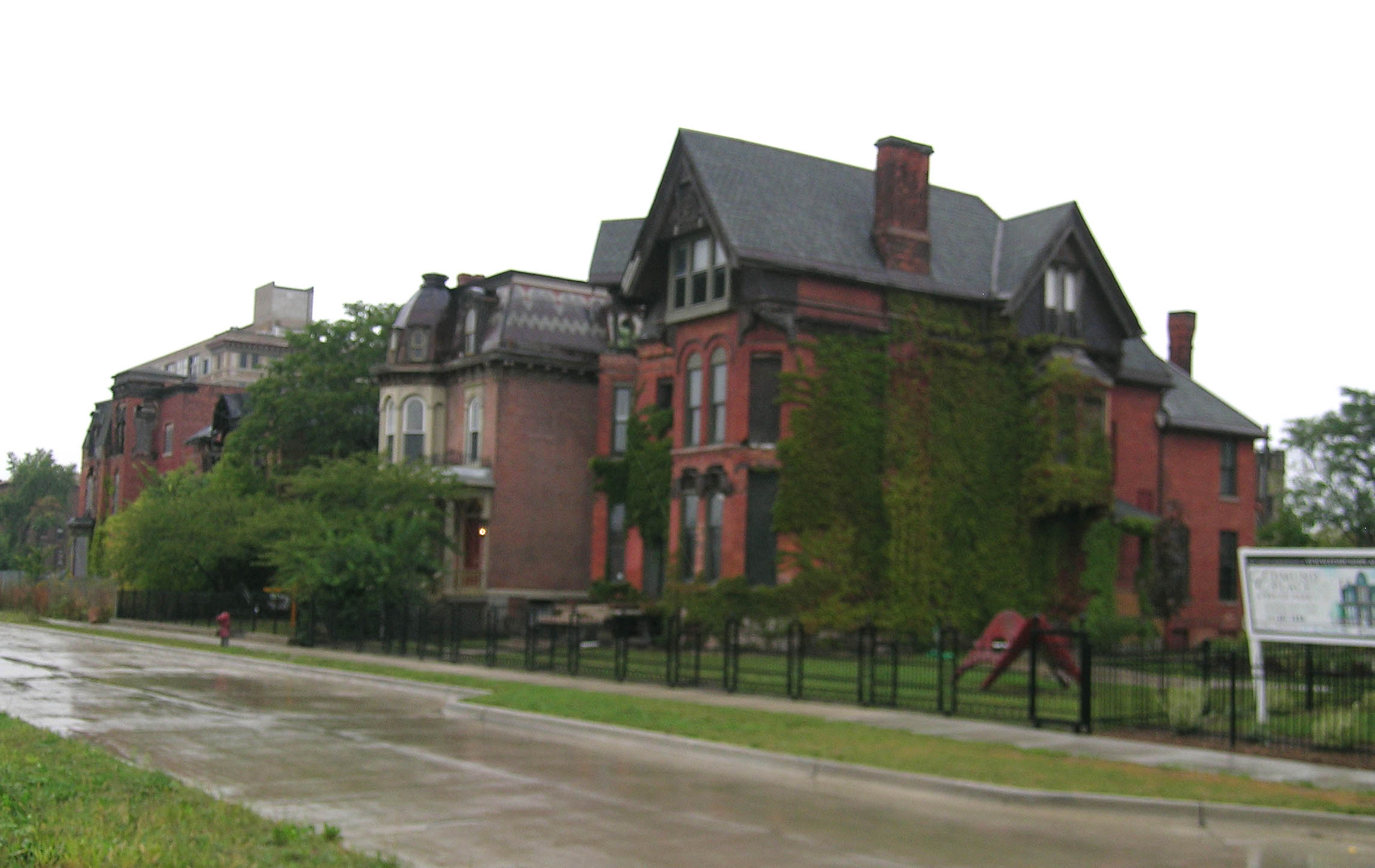- Brush Park, Detroit
Infobox_nrhp | name =Woodward East Historic District
nrhp_type = hd

caption = Streetscape on Edmund
location=Detroit, Michigan
lat_degrees = 42
lat_minutes = 20
lat_seconds = 43
lat_direction = N
long_degrees = 83
long_minutes = 3
long_seconds = 9
long_direction = W
locmapin = Michigan
area =
architect= Unknown
architecture= Late Victorian,Second Empire , Other
added = January 21, 1975
governing_body = Local
refnum=75000973cite web|url=http://www.nr.nps.gov/|title=National Register Information System|date=2008-04-15|work=National Register of Historic Places|publisher=National Park Service]Brush Park Historic District is a 24 block neighborhood in
Detroit ,Michigan .Mullen, Ann, (January 3, 2001). [http://www.metrotimes.com/editorial/story.asp?id=1141 Brush Park and hope] . "Metro Times." Retrieved on June 14, 2008.] It is bounded by Mack on the north,Woodward Avenue on the west, Beaubien on the east, and the Fisher freeway on the south. The neighborhood is experiencing restorations of its historicGilded Age Victorian style homes and luring new residents.Pfeffer, Jaime, (September 12, 2006). [http://www.modeldmedia.com/features/bpark61.aspx Falling for Bush Park] . "Metro Times". Retrieved on June 14, 2008.] Archambault, Dennis (February 14, 2006). [http://www.modeldmedia.com/features/brush.aspx Forging Bush Park] . "Metro Times". Retrieved on June 14, 2008.] This neighborhood is within the larger area known as Midtown.Woodward East Historic District
The Woodward East Historic District is a smaller historic district, recognized by the
National Register of Historic Places , which is completely encompassed by the larger Brush Park neighborhood. The Woodward East Historic District is located on Alfred, Edmund, and Watson Streets from Brush Street to John R Street inDetroit ,Michigan . Woodward East is particularly known for the High Victorian style residences constructed Detroit's wealthiest citizens. Although many of the once-grand houses have been demolished in recent years, those remaining exhibit a variety of Victorian style subtypes [http://www.cityscapedetroit.org/historic_districts.php DETROIT HISTORIC DISTRICS] from CityScape Detroit] and architectural details, includingSecond Empire slateMansard roof s, Romanesque columns and classical dentiled cornices. [http://www.mcgi.state.mi.us/hso/sites/16633.htm Woodward East Historic District] from the state of Michigan]History of Brush Park and Woodward East
Beginning in the 1850s, entrepreneur Edmund Brush began developing his family's property, located conveniently close to downtown, into a neighborhood for Detroit's elite citizens. [http://www.ci.detroit.mi.us/historic/districts/brush_park.pdf Brush Park Historic District] from the City of Detroit] Homes were built in Brush Park beginning in the 1850s and peaking in the 1870s and 1880s; one of the last homes built was constructed in 1906 by architect Albert Kahn for his personal use. Kahn lived in this home until his death in 1942, after which it was obtained by the
Detroit Urban League , which still uses it today. Other early residents of Brush Park includedlumber baron David Whitney Jr. , his daughter Grace Whitney Evans,Joseph L. Hudson , founder of the eponymous department store, and dry goods manufacturer Ransom Gyllis. Architects who designed these mansions includedHenry T. Brush ,George D. Mason , George W. Nettleton, and Albert Kahn.During the 19th century, around 300 homes were built in Brush Park, including 70 Victorian mansions. However, the neighborhood began to decline in the late 19th and early 20th century, when the advent of streetcars and then automobiles allowed prosperous citizens to live further from downtown. Early residents moved out, notably to up-and-coming neighborhoods such as Indian Village and Boston-Edison, and the neighborhood became less fashionable. During the
Great Depression , many of the old mansions were subdivided into apartments, and as demand for housing fell afterWorld War II , the homes were abandoned and fell into disrepair. As of 2001, about 154 original structures remained in the area.Brush Park's revival began in the 1990s and has accelerated recently. A number of the older mansions have been restored, and more have been stabilized. In addition, new condominiums have been built in the southern part of Brush Park, near the Fisher Freeway. [http://www.modeldmedia.com/features/brush.aspx Dennis Archambault,] "Forging Brush Park," 2/14/06]
Structures
Many buildings in the neighborhood are on the State of Michigan Registry of Historic Sites and the
National Register of Historic Places . Some notable buildings in the area include:
*Elisha Taylor House (1870) at 59 Alfred
*Hudson-Evans House (1874) at 79 Alfred
*Bernard Ginsburg House (1898) at Adelaide
*Albert Kahn House (1906) at 208 Mack
*John Harvey House (1887) at 97 Winder
*Ransom Gillis House at 205 Alfred and John R.
*Detroit Society of Arts and Crafts at 47 Watson
*First Unitarian Church of Detroit (1890) at 2870 Woodward at Edmund
*First Presbyterian Church (1889) at 2930 Woodward
*Bonstelle Theatre (1903) at 3424 Woodwardee also
*
David Whitney House References
Wikimedia Foundation. 2010.
